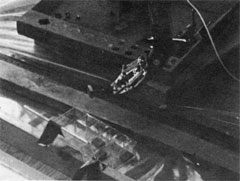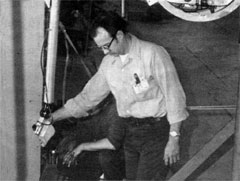NAL Experiment Searches for Magnetic Monopole
Some of the experimental work done at the National Accelerator Laboratory continues lines of scientific thought that have been a part of man's intellectual aggregate for many centuries. Democritus in Greece four centuries before Christ, the Aristotelean theories, and, in some sense, many years of the mysticism of alchemy -- all have been part of the train of thought which searched in depth for an understanding of the internal structure of all matter.
Speculations concerning the possibility of magnetic monopoles are undoubtedly some of the oldest elementary particle ideas around today. The first compass came into use in the 1200's, described by one Peter Peregrini as having "a north pole and south pole." The burst of intellectual thought in the 1800's brought Faraday's explanations of magnetism along with Clerk Maxwell's equations describing the inter-relationship of electricity and magnetism, but raising one question which exists to the present: Complete symmetry between electricity and magnetism could exist if there was a particle with a magnetic pole (a magnetic monopole) comparable to a particle which has one electric charge.
In the flurry of scientific discovery since 1800 and the tidal wave of accompanying technology, ideas about the possibility of a magnetic monopole have been considered but the hunt was not vigorously pursued. In 1973, new speculations were made about the possibility of a magnetic monopole. A search of deep ocean sediment in 1969 as well as a study of samples of moon rock in 1970 failed to find any magnetic monopoles, but did not diminish interest in its possible existence.
The NAL accelerator offered Frank Nezrick, R. Carrigan and B. Strauss an opportunity to begin the search at NAL for the magnetic monopole. The high intensity of the NAL machine gave a much higher flux of protons than the cosmic rays in the natural material used by experimenters before 1973.
In a report to the American Physical Society meeting in Washington , Nezrick said, "The experiment is simple in conception. The proton beam strikes an iron beam 'dump.' Any magnetic monopoles that are created stick to the iron because of magnetic attraction. Later the dump is exposed to a powerful superconducting electromagnet which is strong enough to rip the monopoles away from the iron and accelerate them through a series of special electronic counters where they are identified and recorded."
About fifty 3/8" X 1" X 1.5" target blocks were exposed for 161 hours in Phase I of this experiment at 300 BeV. The experimental equipment was then dismantled and a portion brought to the Village which contained the exposed targets. Because these targets were radioactive, the situation was used as an opportunity for the Target Handling group to demonstrate its ingenious device with electronic fingers for handling radioactive equipment. The device permits an operator to remotely handle radioactive material. The electronic robot daintily picked up the targets, and then placed them in boxes which could be moved to the detector equipment.
In a tense, exciting two hours, Nezrick, Carrigan and Strauss, working along with M. Otavka, fed the targets through their detecting equipment and in the tradition of the scientists who have passed before us, watched for evidence of the elusive particle.
No magnetic monopoles were found in this first phase of the experiment. Targets collected during a 400 BeV run have yet to be analyzed. Further exposures are planned in the Neutrino Laboratory with even longer proton runs.
"If a monopole is there, we have an excellent chance of finding it," Nezrick feels.





